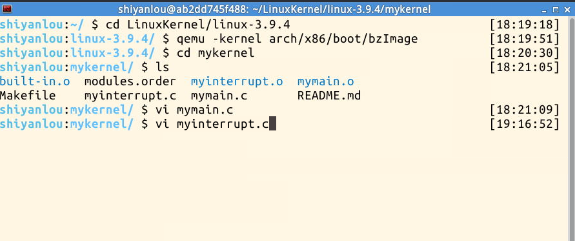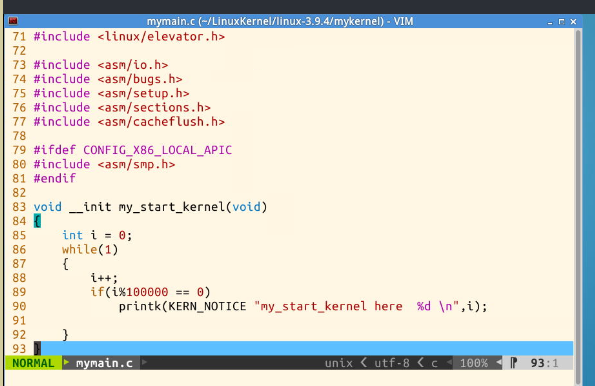Linux内核分析——完成一个简单的时间片轮转多道程序内核代码
张潇月+《Linux内核分析》MOOC课程http://mooc.study.163.com/course/USTC-1000029000
一、实验
打开实验楼,在老师早就建立好的环境里运行并分析一个简单的操作系统内核。
首先是进入老师搭建的平台

然后cd mykernel 您可以看到qemu窗口输出的内容的代码mymain.c和myinterrupt.c



以上是本次实验过程截图。
二、分析实验代码
Mymain.c
/*
* linux/mykernel/mymain.c
*
* Kernel internal my_start_kernel
*
* Copyright (C) 2013 Mengning
*
*/
#include <linux/types.h>
#include <linux/string.h>
#include <linux/ctype.h>
#include <linux/tty.h>
#include <linux/vmalloc.h>
#include "mypcb.h"
tPCB task[MAX_TASK_NUM];
tPCB * my_current_task = NULL;
volatile int my_need_sched = 0;/*是否需要调度*/
void my_process(void);
void __init my_start_kernel(void)
{
int pid = 0;
int i;
/* Initialize process 0*/
task[pid].pid = pid;
task[pid].state = 0;/* 0号进程*/
task[pid].task_entry = task[pid].thread.ip = (unsigned long)my_process;
task[pid].thread.sp = (unsigned long)&task[pid].stack[KERNEL_STACK_SIZE-1];
task[pid].next = &task[pid];
/*fork more process */
for(i=1;i<MAX_TASK_NUM;i++)
{
memcpy(&task[i],&task[0],sizeof(tPCB));
task[i].pid = i;
task[i].state = -1;
task[i].thread.sp = (unsigned long)&task[i].stack[KERNEL_STACK_SIZE-1];
task[i].next = task[i-1].next;
task[i-1].next = &task[i];
}
/* start process 0 by task[0] */
pid = 0;/*0号进程开始执行*/
my_current_task = &task[pid];
asm volatile(
"movl %1,%%esp " /*%1表示下面的参数sp*/
"pushl %1 " /* push ebp */
"pushl %0 " /* push task[pid].thread.ip */
"ret " /* pop task[pid].thread.ip to eip */
"popl %%ebp "
:
: "c" (task[pid].thread.ip),"d" (task[pid].thread.sp) /* input c or d mean %ecx/%edx*/
);
}
void my_process(void)
{
int i = 0;
while(1)
{
i++;
if(i%10000000 == 0)
{
printk(KERN_NOTICE "this is process %d - ",my_current_task->pid);/*主动调度,执行一千万次才调度一次*/
if(my_need_sched == 1)
{
my_need_sched = 0;
my_schedule();
}
printk(KERN_NOTICE "this is process %d + ",my_current_task->pid);
}
}
}
Myinterrupt.c
/*
* linux/mykernel/myinterrupt.c
*
* Kernel internal my_timer_handler
*
* Copyright (C) 2013 Mengning
*
*/
#include <linux/types.h>
#include <linux/string.h>
#include <linux/ctype.h>
#include <linux/tty.h>
#include <linux/vmalloc.h>
#include "mypcb.h"
extern tPCB task[MAX_TASK_NUM];
extern tPCB * my_current_task;
extern volatile int my_need_sched;
volatile int time_count = 0;
/*
* Called by timer interrupt.
* it runs in the name of current running process,
* so it use kernel stack of current running process
*/
void my_timer_handler(void)
{
#if 1
if(time_count%1000 == 0 && my_need_sched != 1)
{
printk(KERN_NOTICE ">>>my_timer_handler here<<< ");
my_need_sched = 1;
}
time_count ++ ;
#endif
return;
}
void my_schedule(void)
{
tPCB * next;
tPCB * prev;
if(my_current_task == NULL
|| my_current_task->next == NULL)
{
return;
}
printk(KERN_NOTICE ">>>my_schedule<<< ");
/* schedule */
next = my_current_task->next;
prev = my_current_task;
if(next->state == 0)/* -1 unrunnable, 0 runnable, >0 stopped */
{
/* switch to next process */
asm volatile(
"pushl %%ebp " /* save ebp */
"movl %%esp,%0 " /* save esp */
"movl %2,%%esp " /* restore esp */
"movl $1f,%1 " /* save eip */
"pushl %3 "
"ret " /* restore eip */
"1: " /* next process start here */
"popl %%ebp "
: "=m" (prev->thread.sp),"=m" (prev->thread.ip)
: "m" (next->thread.sp),"m" (next->thread.ip)
);
my_current_task = next;
printk(KERN_NOTICE ">>>switch %d to %d<<< ",prev->pid,next->pid);
}
else
{
next->state = 0;
my_current_task = next;
printk(KERN_NOTICE ">>>switch %d to %d<<< ",prev->pid,next->pid);
/* switch to new process */
asm volatile(
"pushl %%ebp " /* save ebp */
"movl %%esp,%0 " /* save esp */
"movl %2,%%esp " /* restore esp */
"movl %2,%%ebp " /* restore ebp */
"movl $1f,%1 " /* save eip */
"pushl %3 "
"ret " /* restore eip */
: "=m" (prev->thread.sp),"=m" (prev->thread.ip)
: "m" (next->thread.sp),"m" (next->thread.ip)
);
}
return;
}
Mypcb.c
/*
* linux/mykernel/mypcb.h
*
* Kernel internal PCB types
*
* Copyright (C) 2013 Mengning
*
*/
#define MAX_TASK_NUM 4
#define KERNEL_STACK_SIZE 1024*8
/* CPU-specific state of this task */
struct Thread {
unsigned long ip;
unsigned long sp; /*用thread来存储ip,sp*/
};
typedef struct PCB{
int pid;
volatile long state; /* -1 unrunnable, 0 runnable, >0 stopped */
char stack[KERNEL_STACK_SIZE];
/* CPU-specific state of this task */
struct Thread thread;
unsigned long task_entry;/*进程入口*/
struct PCB *next;/*把进程用链表链接起来*/
}tPCB;
void my_schedule(void);
三、操作系统是怎么工作?
程序在经过编译链接后形成可执行程序。在加载到内存时,系统根据可执行程序初始化进程的地址空间。CPU根据ebp/eip寻址进程地址空间中的cs段的代码,取值,译码并依次执行,进行数据处理。在函数调用时,会先把参数压栈,接着执行call指令-压栈参数cs:eip并跳转到被调用函数的cs段,然后构造被调函数的堆栈,之后,同样的取值,译码并执行,进行数据处理。在被调用函数结尾,会恢复调用函数的cs段的指令。